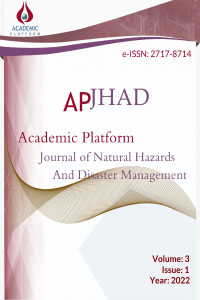Abstract
References
- [1] T. C. Hansen, “Recycling of demolished concrete and masonry,” London, E&FN SPON, 1992.
- [2] F. M. Khalaf, A.S. DeVenny, “Recycling of demolished masonry rubble as coarse aggregate in concrete: review,” J. Mater. Civ. Eng.,16 (4), 331-340, 2004.
- [3] C. Goksu, I. Saribas, E. Binbir, Y. Akkaya, A. Ilki, “Structural behavior of recycled aggregates concrete obtained from low quality concrete,” Struc. Eng. Mech., 69 (1), 77-93, 2019.
- [4] I. Saribas, C. Goksu, E. Binbir, A. Ilki, “Seismic performance of full-scale RC columns containing high proportion recycled aggregate,” Bull. Earthquake Eng., 17 (11), 6009-6037, 2019.
- [5] I. Saribas, C. Goksu, E. Binbir, A. Ilki, “Shear-flexure interaction in RAC columns under simulated seismic actions,” Eng. Struc., 231, 111746, 2021.
- [6] Turkish Seismic Design Code (TSDC-18), “Regulations for Buildings to be constructed in Earthquake Prone Areas,” Ankara, Turkey, (2018).
- [7] E. Hognestad, “A study of combined bending and axial load in reinforced concrete members,” University of Illinois Bulletin, 49(22), 1951.
- [8] I. Saribas, “Stress-strain model for recycled aggregate concretes,” El-Cezerî J of Sci and Eng 6(1), 156-165, 2019.
- [9] A. S. Elnashai, “A very brief history of earthquake engineering with emphasis on developments in and from the British Isles,” Chaos Soliton. Fract, 13(5), 967-972, 2002.
- [10] D. Mitchell, P. Paultre, R. Tinawi, M. Saatcioglu, R. Tremblay, K. Elwood, J. Adams, R. DeVall, “Evolution of seismic design provisions in the National building code of Canada,” Can. J. Civ. Eng. 37, 1157-1170, 2010.
- [11] R. Reitherman, “Earthquake that initiated the development of earthquake engineering,” Bull. NZSEE, 39(3), 145-157, 2006.
- [12] N. Bourahla, “Equivalent Static Analysis of Structures Subjected to Seismic Actions,” Encyclopedia of Earthquake Engineering, 2013, DOI 10.1007/978-3-642-36197-5_169-1.
- [13] CSI, “SAP2000 Integrated Software for Structural Analysis and Design,” Computers and Structures Inc., Berkeley, California.
- [14] XTRACT 3.0.8: Cross-sectional structural analysis of components. TRC, Rancho Cordova, 2007.
- [15] J. B. Mander, M. J. N. Priestley, R. Park, “Theoretical stress-strain model for confined concrete,” ASCE J. Struct. Eng. 114(8), 1804-1826, 1988.
Abstract
The utilization of sustainable concrete in producing reinforced concrete structures subjected to seismic actions is one of the leading research topics of recent years. With the technical exhibition that this concrete may be used in conventional reinforced concrete structures, a significant threshold for this sustainable material is accomplished. In the scope of this study, the seismic behavior of five different reinforced concrete structures under seismic actions, which are considered to be produced from sustainable concrete and conventional concrete, was investigated in detail. The geometrical, cross-section, and longitudinal section dimensions of these reinforced concrete structures are convenient for the equivalent seismic load method to use effectively. Furthermore, the Turkish Building Seismic Code limits were considered for the numerical simulation of reinforced concrete structures. Based on this detailed seismic simulation, the equivalent seismic load method may be used in earthquake simulation of reinforced concrete structures incorporating sustainable concrete. Furthermore, the numerical simulation results obtained from the sustainable concrete structures were extensively compared with the conventional concrete structures results. It may be concluded from these results that there are negligible differences between the seismic performance indicators of reinforced sustainable concrete structures and conventional concrete structures.
Keywords
Equivalent seismic load method Natural aggregate Recycled concrete aggregate Reinforced Concrete Seismic Sustainable concrete
References
- [1] T. C. Hansen, “Recycling of demolished concrete and masonry,” London, E&FN SPON, 1992.
- [2] F. M. Khalaf, A.S. DeVenny, “Recycling of demolished masonry rubble as coarse aggregate in concrete: review,” J. Mater. Civ. Eng.,16 (4), 331-340, 2004.
- [3] C. Goksu, I. Saribas, E. Binbir, Y. Akkaya, A. Ilki, “Structural behavior of recycled aggregates concrete obtained from low quality concrete,” Struc. Eng. Mech., 69 (1), 77-93, 2019.
- [4] I. Saribas, C. Goksu, E. Binbir, A. Ilki, “Seismic performance of full-scale RC columns containing high proportion recycled aggregate,” Bull. Earthquake Eng., 17 (11), 6009-6037, 2019.
- [5] I. Saribas, C. Goksu, E. Binbir, A. Ilki, “Shear-flexure interaction in RAC columns under simulated seismic actions,” Eng. Struc., 231, 111746, 2021.
- [6] Turkish Seismic Design Code (TSDC-18), “Regulations for Buildings to be constructed in Earthquake Prone Areas,” Ankara, Turkey, (2018).
- [7] E. Hognestad, “A study of combined bending and axial load in reinforced concrete members,” University of Illinois Bulletin, 49(22), 1951.
- [8] I. Saribas, “Stress-strain model for recycled aggregate concretes,” El-Cezerî J of Sci and Eng 6(1), 156-165, 2019.
- [9] A. S. Elnashai, “A very brief history of earthquake engineering with emphasis on developments in and from the British Isles,” Chaos Soliton. Fract, 13(5), 967-972, 2002.
- [10] D. Mitchell, P. Paultre, R. Tinawi, M. Saatcioglu, R. Tremblay, K. Elwood, J. Adams, R. DeVall, “Evolution of seismic design provisions in the National building code of Canada,” Can. J. Civ. Eng. 37, 1157-1170, 2010.
- [11] R. Reitherman, “Earthquake that initiated the development of earthquake engineering,” Bull. NZSEE, 39(3), 145-157, 2006.
- [12] N. Bourahla, “Equivalent Static Analysis of Structures Subjected to Seismic Actions,” Encyclopedia of Earthquake Engineering, 2013, DOI 10.1007/978-3-642-36197-5_169-1.
- [13] CSI, “SAP2000 Integrated Software for Structural Analysis and Design,” Computers and Structures Inc., Berkeley, California.
- [14] XTRACT 3.0.8: Cross-sectional structural analysis of components. TRC, Rancho Cordova, 2007.
- [15] J. B. Mander, M. J. N. Priestley, R. Park, “Theoretical stress-strain model for confined concrete,” ASCE J. Struct. Eng. 114(8), 1804-1826, 1988.
Details
| Primary Language | English |
|---|---|
| Subjects | Civil Engineering |
| Journal Section | Research Articles |
| Authors | |
| Publication Date | June 27, 2022 |
| Submission Date | June 6, 2022 |
| Published in Issue | Year 2022 Volume: 3 Issue: 1 |


